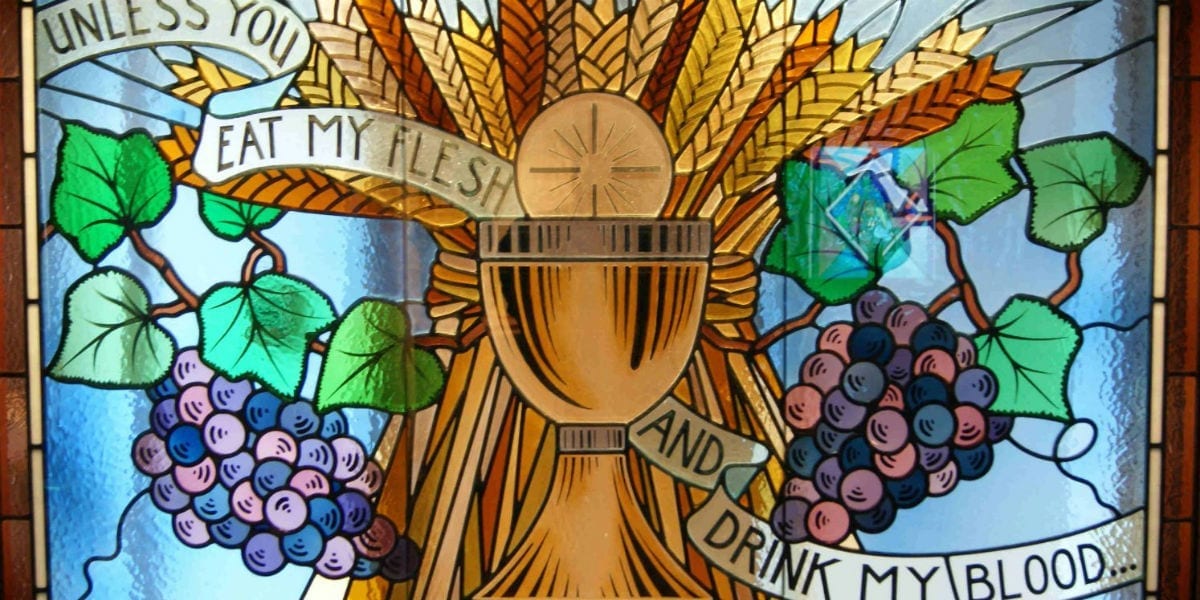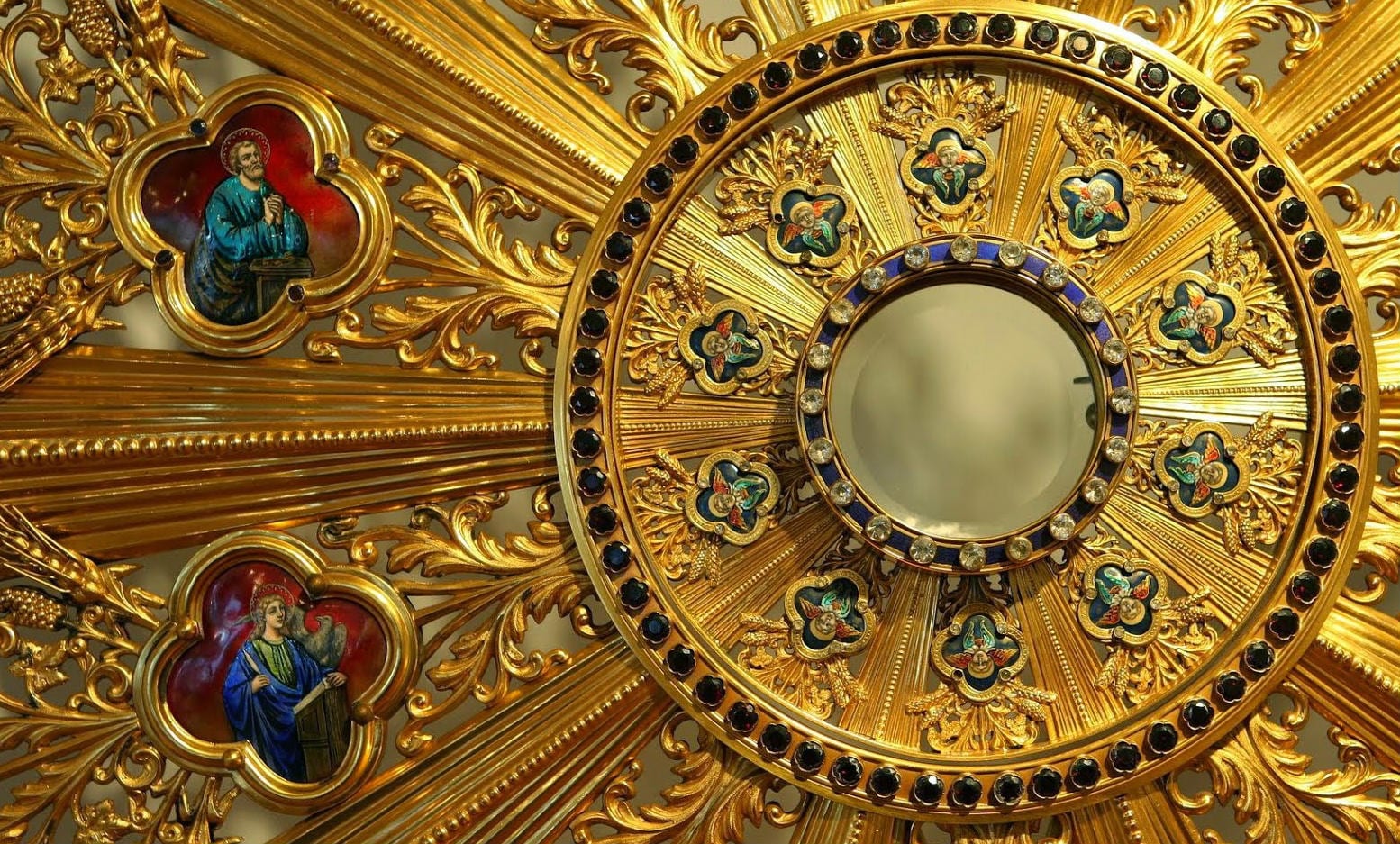Regina Caeli – Queen of Heaven, Rejoice!
The Regina Caeli, Latin for “Queen of Heaven,” is a hymn and prayer ...

This post is also available in: Italian
This fourth installment in a five part series on Understanding the Mass explains Christ’s real presence in the Word of God and in the sacrament of his body and blood.
As we have seen, the Lord Jesus is really and truly present in the Mass in at least four distinct ways. In our last article, we discussed His presence in the people and in the person of the priest. Now it is time to examine the third way He is present in the Mass, in the word of God. It’s a caricature to depict the Protestant church as the church of the word and the Catholic Church as the church of the sacraments. This is certainly not the case.
The Catholic Church sees the Bible, the inspired word of God, as a priceless gift, and this is reflected in the Eucharist. In fact, the first part of the Mass centers on readings from scripture: one passage, a psalm response, sometimes another passage, and then a reading from one of the Gospels.
This Liturgy of the Word isn’t an abstract catechism lesson. Through the readings, the Lord wants to speak to us personally, cutting through all our defenses and penetrating to the depths of our hearts with a nourishing, challenging word leading us to conversion. This has happened time and time again in the Church’s history.
Francis Bernardone, son of a cloth merchant in Assisi, walked into church one day during a period when he was searching for meaning in life. He opened the lectionary to this text: “Go, sell what you have, give to the poor, and come, follow me” (cf. Mark 10:21). Francis knew this word wasn’t just for the Apostles 1200 years earlier; it was for him, right there and then. He walked out of church, did exactly what that scripture said, and so began a world-wide spiritual revolution that still impacts us today.
My own conversion began in a similar way. I had never missed Sunday Mass except when ill, but it didn’t mean a whole lot to me. I kept showing up, though, and because I was there, the Spirit suddenly one Sunday gave me ears to hear. The gospel reading — Jesus’ calling Peter to come and follow him — penetrated to the depths of my being. I was so impressed that I ripped out the reading from the missalette, took it home, and put it up on my wall. I started reading Scripture, and before long my life was transformed.
This is how the Lord wants to work in our lives, and we can cooperate by cultivating openness to the word heard at Mass. It’s not just at the table of the Eucharist that we’re nourished. The pulpit is like a table too, as the Second Vatican Council explains: “The Church has always venerated the divine Scriptures just as she venerates the body of the Lord, since from the table of both the word of God and of the body of Christ she unceasingly receives and offers to the faithful the bread of life, especially in the sacred liturgy” (Dei verbum, paragraph 21). We read the Scriptures first because they build up our faith. Christ is present in them, preparing us to discern the Real Presence of His Body and Blood under the signs of bread and wine.
In addition to the readings, the word of God comes to us through the prayers of Mass. Listen carefully, and you’ll discover that these prayers are almost entirely scriptural. They’re either direct quotes or paraphrases like the Creed, which the Church Fathers put together as a summary of the essential scriptures.
Take the greeting that the priest usually gives us when he walks in: “May the grace of our Lord Jesus Christ, the love of God, and the fellowship of the Holy Spirit be with you all.” That’s a direct quote from St. Paul: 2 Corinthians 13:13. Or the Gloria that we pray on most Sundays: “Glory to God in the highest, and on earth peace to people of good will.” That’s Luke 2:14. At every Mass we sing “Holy, holy, holy, Lord, God of hosts.” That’s Isaiah 6:3, with a bit of another scripture passage thrown in toward the end. What about “Behold, the Lamb of God, who takes away the sins of the world”? That’s what John the Baptist said (Jn 1:29). And then there’s my favorite, that great Italian, the centurion who told the Lord he wasn’t worthy to welcome him under his roof (cf. Mt 8:8); we quote him every time we pray, “Lord, I am not worthy that you should enter under my roof….”

The final and most special way that the Lord is present in the Eucharist is in His Body and Blood, present to us under the signs of bread and wine.
Jesus is God, and so He is omnipresent. But Jesus is man as well as God; His humanity can’t be present everywhere in the same way as His divinity. Jesus’ glorified humanity is at the right hand of the Father. In the Eucharist and only in the Eucharist, though, He makes His Body and Blood present to us in a totally real way. This is why the sacramental presence of Christ’s Body and Blood is so extraordinary. In all of the other sacraments Jesus gives us His grace, says St. Thomas Aquinas, while in the Eucharist, the “sacrament of sacraments,” He gives us His whole self, His divinity and His humanity.
How is this possible? How can Jesus be present bodily under the forms of bread and wine? Many people have the impression that it’s all hocus-pocus. But the Eucharist is emphatically not magic. Rather, the transformation of bread and wine into Christ’s Body and Blood happens the same way Mary’s virginal conception did: through the power of the Word and the power of the Spirit. The incarnation may seem impossible, yet all Christians believe it. It happens the same way creation did: God spoke and the world was made out of nothing through the power of the Word and the Spirit. Likewise, in the Eucharist, the One who said “let there be light” says “this is My Body” and “this is My Blood.” Through the power of the Spirit invoked upon the gifts, an awesome change takes place.
About the year 1200 or so, as some Catholics were struggling to find a way to explain this change, they came up with the word “transubstantiation.” Many people struggle with this word today! One reason why we find it hard to understand is that the word “substance” has different meanings. For us, substance is something you can touch. Substance abuse, for example, has to do with tangibles like drugs and alcohol. In theology, though, substance means something that underlies what you can see and touch; it’s the unchanging essence of the thing that resides under its appearances. Surface characteristics — “accidents,” as theologians call them — have to do with everything that could be otherwise, be changed or altered — say, how long your hair is or how fat or thin you are.
Transubstantiation, therefore, means that while everything looks the same on the surface, the underlying essence of a thing is changed. This is just the opposite of what happens in the world we see. Usually, appearances change while the essence of a thing stays the same. In the Eucharist, though, the underlying, invisible substance is transformed from bread and wine to Christ’s Body and Blood. Everything looks the same as before. Even with a microscope, you wouldn’t be able to tell the difference, for the level at which this change happens is far too deep for human probing. But in the Eucharist, Christ is as truly present in His Body, Blood, soul, and divinity as when He walked the roads of Galilee, healing and preaching.
This article on the Real Presence of Christ in the Word of God and the sacrament of his body and blood is part 4 of a Five Part Series on Understanding the Mass, click to read Part I, Part II, Part III, and Part V.
No Comments